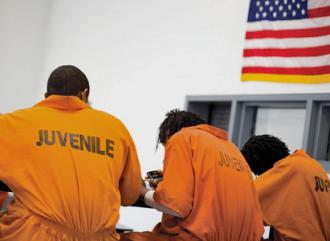explains how a minor offense in school can turn into a prison sentence.
 Youth incarcerated in the juvenile system
Youth incarcerated in the juvenile system
ON ONE level, Kids for Cash: Two Judges, Thousands of Children and a $2.8 Million Kickback Scheme by William Ecenbarger is a true-crime story about corrupt judges.
Two judges from Luzerne County in northeastern Pennsylvania were convicted in federal court in 2010 and 2011 of racketeering for accepting nearly $3 million in kickbacks over five years from the operator of a for-profit juvenile detention facility. In return, the judges ensured that the facilities remained filled with kids charged with offenses in delinquency court.
As a result, the rate of incarceration for youth found delinquent in Luzerne County was roughly two times the statewide average, and the percentage of youth appearing without an attorney was nearly 10 times the percentage for the state.
Mark Ciavarella was the only judge in the county presiding over delinquency cases, while Michael Conahan was the supervising judge for the county courts. Conahan made the scheme possible by ordering the closure of a county-run detention facility, clearing the way for privatization.
Ciavarella ran a kangaroo court where youth were denied the right to legal representation and routinely sent away for long periods of detention after hearings that tended to last just a few minutes.
The judges gave every indication of regarding themselves as pillars of the community, and the repulsiveness of their characters and crimes makes for a compelling story, topped off with the satisfaction of their well-deserved loss of status and prison terms that will keep them locked up for many years.
On another level, the book tells the story of trends in juvenile "justice" that were not unique to Luzerne County, but were simply taken to a shocking extreme. Ecenbarger is a journalist who covered the kids-for-cash scandal for the Philadelphia Enquirer, and for the book, he broadened the story somewhat to place it in the context of changes in the treatment of juveniles by schools, police and courts.
REVIEW: BOOKS
William Ecenbarger, Kids for Cash: Two Judges, Thousands of Children and a $2.8 Million Kickback Scheme, New Press, 304 pages, $26.95.
- - - - - - - - - - - - - - - -
THE CASE gathered national attention when the federal indictments were announced, and caused a local sensation. The focus on the kickbacks, however, meant that the most troubling aspect of the story was overshadowed.
With only a handful of exceptions, people who were knowledgeable about the sentencing practices in Luzerne County either supported them enthusiastically or failed to object. This included the prosecutors who accepted effortless "wins" and ignored clear violations of children's rights, the probation department that helped to railroad children coming before the court, and the public defender's office which acquiesced in denial of the right to counsel to keep caseloads low.
The schools were equally compromised. Ecenbarger points out the role they played in furthering the judge's crimes:
By 2005, school officials were well aware that the one certain way to rid themselves of a troublemaker was to call the police, because this would get the child before Ciavarella. These kids were not only disciplinary headaches, they often were low achievers academically and dragged down test scores, making it doubly desirable to get rid of them. Behaviors that once were matters of in-school discipline--shoving matches, foul language, disrespect to teachers--were elevated to law enforcement issues...In short, Luzerne County educators used Ciavarella as their chief disciplinarian.
Schools regularly invited Ciavarella to address student assemblies, where he took delight in threatening the kids with what he would do to them if they ever found themselves in his courtroom. When he was handing down sentences, he couldn't spare the time to advise the youth standing before him of their right to legal representation or to inquire into their life circumstances. But he did find the time for a standardized "I-told-you-so" q-and-a, asking them to remember what he had told them he would do at school assemblies before sending them away to detention.
Often, the conduct involved was typical teen rebellion--what might be characterized as "age-appropriate misbehavior." When the investigation began, two school administrators from a vocational school wrote a letter to a local newspaper praising Ciavarella and his tough love approach.
Parents of children locked up for months were dismayed that Ciavarella's trial focused on the kickbacks and largely ignored the consequences for the children. What they came to understand was that it was only the kickbacks that distinguished Luzerne County from other jurisdictions that have embraced "zero tolerance" and "scared straight" approaches, boot camps and shock incarceration programs and privatized detention.
In his concluding chapter, Ecenbarger raises the questions:
Were it not for the millions of dollars in bribes, how much of a public outcry would there have been against the actions of these two judges? What voices would have been raised if the only wrongdoing was Ciavarella's everyday denial of the basic rights of children? It is unsettling to speculate.
Ecenbarger summarizes the problem of privatized jails for kids in a quote from the Juvenile Law Center in Philadelphia:
It is axiomatic that for-profit programs are in the business of making money. While detention centers provide some short-term services to youth, their primary mission is control. At their core, detention centers ensure that a youth will show up at trial and not commit an offense prior to trial. For-profit detention centers make their profit based on a headcount. While public detention centers will stay in business even if their populations are low, for-profit detention centers cannot afford low populations.
Thus, a privatized system is based on a business model requiring an adequate supply of young people to operate at capacity and maintain cash flow.
- - - - - - - - - - - - - - - -
ECENBARGER DOESN'T deal with the role of race in the juvenile justice system, so Kids for Cash will never be a comprehensive representation of the part that delinquency courts and youth detention play in the school-to-prison pipeline.
This isn't really Ecenbarger's fault, as the kids-for-cash scandal emerged in a white working-class community in the declining anthracite coal-mining region of northeastern Pennsylvania. Ecenbarger came to the story as a reporter without substantial exposure to juvenile justice issues, so his analysis is largely limited to what he found in Luzerne County.
In describing the context for the book, however, he might have noted that Luzerne County was an anomaly, and that the policies he describes are disproportionately applied to children and youth of color.
What Ecenbarger can be faulted for is his repeated references to "tough, inner-city kids" detained for drug involvement, in relating stories about teens from Luzerne County sent to detention. By highlighting the plight of a youth locked up for throwing a piece of steak at his stepfather during an argument, for example, who was forced to associate with other kids locked up for dealing drugs, Ecenbarger seems to be suggesting that the latter deserve to be incarcerated.
These passages are jarring, in that suburban white teens are just as likely as "tough, inner-city" teens, presumably of color, to handle and use drugs. The youth of color, however, are overwhelmingly more likely to be arrested and detained for doing so. It seems not to have occurred to Ecenbarger to ask whether locking kids up for street-level drug transactions makes any more sense than for truancy, fighting in school or disrespecting their parents.
We may never see another kids-for-cash scandal exactly like Luzerne County, with arrogant, greedy judges pocketing kickbacks in exchange for juvenile detention placements, but the worst parts of the story continue to play out all over the country.
Schools still criminalize youth by calling police to handle issues that educators should deal with, and delinquency courts still send kids to detention programs for offenses that should never result in a custodial sentence. Often, they are locked up for offenses that couldn't be prosecuted in adult courts.
In October 2012, the federal government's Justice Department filed a lawsuit against the state of Mississippi and various government bodies in the city of Meridian for policies very much like those at issue in Luzerne County. In the complaint, the Justice Department claims the Meridian school district developed new policies to call the police and have students arrested for "crimes" such as using profanity, disrespect and failing to obey a teacher's directions.
The courts, probation and other agencies cooperated by promptly locking the children up without troubling themselves with the niceties of due process and effective legal representation. Every child arrested at the request of the school district was African American.
Perhaps the most interesting line in the complaint is the statement, "Defendants in this case collectively help to operate a school-to-prison pipeline." It's a surprisingly concise and accurate statement for a formal legal document, but there are many ways in which the same accusation can be made against the U.S. Justice Department.
Despite its limited perspective, Kids for Cash is a compelling story about how the zero-tolerance culture has corrupted schools, and about the nuts and bolts of the school-to-prison pipeline. It also helps to explain how privatization of youth incarceration imposes a business model in which children and youth are raw materials and the role of the courts is to maintain an adequate supply.

No comments:
Post a Comment